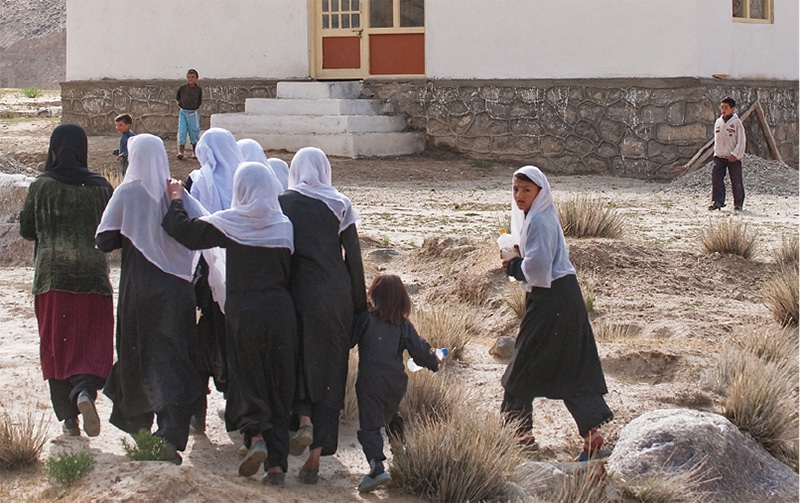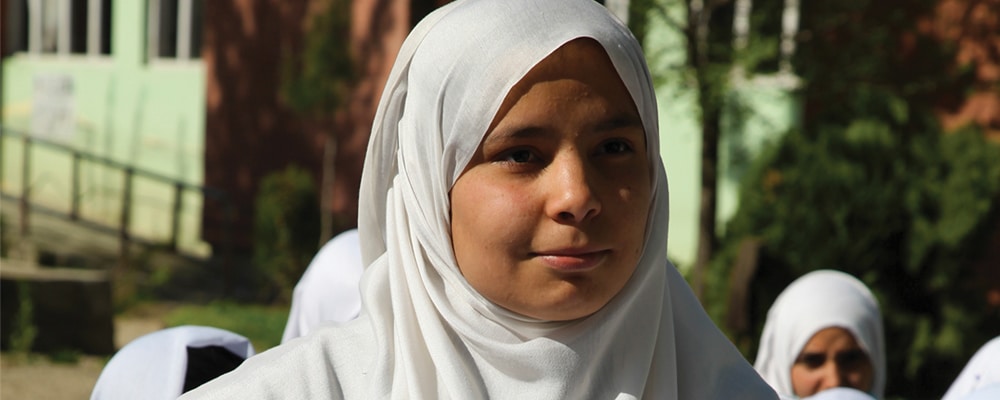Girls’ education in Afghanistan: Sowing the seeds of hope for a better future
By Alice Thomas
Afghan women and girls face an uncertain and ominous future.
Now that U.S. and NATO forces have withdrawn and the Taliban has regained power, women and girls fear a return to the brutal repression of freedoms and rights they experienced two decades ago. Unfortunately, it is becoming more and more apparent that these fears could become reality.
Despite promises to the contrary, the Taliban’s new cabinet does not include a single woman. The Ministry of Women’s Affairs has been disbanded and supplanted with a Ministry of Virtue and Vice, known under the prior regime for brutally enforcing the group’s strict interpretation of Islam under Sharia law. In addition, within weeks of the Taliban’s coming to power, the rights of Afghan women and girls to education and work were already being significantly curtailed—not to mention the broader rights of all Afghans to freedom of religion and movement. All around the country, there are reports that women who previously worked in government offices, banks, and other businesses are being told to go home “where they belong.”
While primary schools have continued to operate for girls and boys, in late September, the education ministry ordered male students and teachers back to high school, but made no mention of female students, raising fears that girls would be banned from attending school beyond the sixth grade. Following public outrage, the Taliban quickly backed down, announcing girls would be permitted to return to secondary school “soon.” But what that will look like and under what conditions remains uncertain.i
In some regions of the country, female students have been prohibited from attending university, including Kabul University, the country’s premier public university. In late September, the school’s new, Taliban-appointed chancellor proclaimed that female students and teachers would be banned altogether from attending.ii More broadly, the Taliban’s new education minister recently declared that going forward, women and men must be educated and work separately. This would effectively act to limit girls’ ability to attend anything beyond primary school given the limited number of high school and university teachers who are female. Women who have been permitted to attend certain universities are also being forced to wear long, black abayas that cover their entire bodies and a niqab over their faces, leaving just their eyes uncovered.
For Afghan women and girls, the extent of sorrow and loss they are feeling cannot be overstated.

The promise of education
But there may be reason for hope. Today’s Afghanistan is different in important ways from when the Taliban last held power. There has been significant progress in Afghan women’s and girls’ access to education, jobs, and political participation. Most notably, literacy rates among girls have doubled. Of the 9 million students enrolled in school in 2018, 3.8 million were female. When compared to 2001, when virtually no girls were enrolled in school, this represents enormous progress.iii
In urban areas, before the recent takeover by the Taliban, 45% of girls attended secondary school. (Although in rural areas, progress has been much slower with only 17% of girls advancing to secondary school.) Over the past 20 years, the number of schools increased 10 times and the number of female primary teachers grew to approximately one-third of the nation’s teachers.iv Public support for education has also dramatically increased. A 2019 survey across all 34 of the country’s provinces found that 87% of women and 85% of men supported women’s access to education.v
In the past two decades, women have also seen important gains in terms of access to jobs. As of 2017, approximately 40% of working-age adults were female. There are more women-run businesses than there were 20 years ago, and there have been meaningful improvements in women’s participation in the Afghan Parliament, police, and judiciary. While surely not enough, these are nonetheless important milestones of progress.vi
With the situation still evolving, it is this generation of educated women who are emerging as seeds of hope. As of late September, women across Afghanistan were publicly protesting Taliban edicts that would ban them from holding government office and entering the workforce. They are risking their lives, knowing that such protests have already been brutally repressed. But they have not been deterred, and the world has been astounded by their bravery.
Afghan women inside and outside of the country recently launched an online media campaign protesting the new restrictions on dress. Using hashtags like #DoNotTouchMyClothes and #AfghanistanCulture, women are posting pictures of themselves on social media wearing traditional Afghan women’s clothing characterized by bright colors and embellished with embroidery and small sparkling mirrors. In doing so, these women are not only rejecting niqabs and burkas but reclaiming their identities as well. As one Afghan women’s rights advocate explained, “Our traditional clothes represent our rich culture and history of 5,000 years, which makes every Afghan feel proud of who they are.”vii
Propelling these brave women is the thought of a life without the rights to work, education, or self-determination; a life confined to their homes; and a life stripped of books, music, laughter, and hope. For them, this is no life at all.

What can we expect from the Taliban in terms of girls’ access to education?
What girls’ education will look like under Taliban rule is far from clear. In Central Asia Institute’s experience, even in those areas that have long been under Taliban control, practices can vary when it comes to what is acceptable. Whether this will continue to be the case now that the Taliban rules the entire country is hard to say. But among the Taliban, significant differences of opinion with respect to education suggest that going forward, a uniform approach to girls’ education may be hard to achieve. Recently, there have been disagreements between hardliners and those who recognize that Afghanistan needs a better and more modern educational system.viii
It is true that for now, Afghanistan’s women and girls face a dark future. Yet there is an entirely new generation of Afghan women and girls who have emerged over the past two decades. They are both proof and hope of what remains possible. Education will empower Afghan women and men all over the world to fight for a better future for themselves, their families, and their country.
i. Zucchino, D., & Blue, V. (2021, September). A Harsh New Reality for Afghan Women and Girls in Taliban-Run Schools. In The New York Times. https://www.nytimes.com/2021/09/20/world/asia/afghan-girls-schools-taliban.html
ii. Engelbrecht, C., & Hassan, S. (2021, September). New Taliban Chancellor Bars Women from Kabul University. In The New York Times. https://www.nytimes.com/2021/09/27/world/asia/taliban-women-kabul-university.html
iii. The Right to Education: What’s at Stake in Afghanistan, 20 Year Review (2021, September). In UNESCO. https://en.unesco.org/news/unesco-sounds-warning-what-stake-education-afghanistan
iv. Afghanistan: Women’s Economic, Political, Social Status Driven by Cultural Norms (2021, April). In National Intelligence Council. https://www.dni.gov/files/ODNI/documents/assessments/SOCM-AFG_Women.pdf
v. A Survey of the Afghan People: Afghanistan in 2019: Infographics (2019, December). In The Asia Foundation.
vi. Supra note iv
vii. Afghan women hit back at Taliban with #DoNotTouchMyClothes campaign (2021, September). In BBC. https://www.bbc.com/news/world-asia-58550335
viii. Supra note iv
*The situation in Afghanistan is changing rapidly. For the most up-to-date information about what’s happening on the ground and our efforts to support the Afghan people, please visit centralasiainstitute.org






